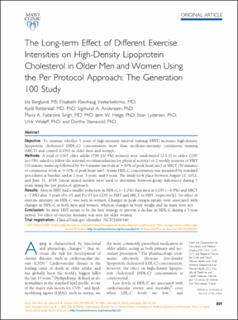| dc.contributor.author | Berglund, Ida Johnsen | |
| dc.contributor.author | Vesterbekkmo, Elisabeth Kleivhaug | |
| dc.contributor.author | Retterstøl, Kjetil | |
| dc.contributor.author | Anderssen, Sigmund Alfred | |
| dc.contributor.author | Singh, Maria A. Fiatarone | |
| dc.contributor.author | Helge, Jørn Wulff | |
| dc.contributor.author | Lydersen, Stian | |
| dc.contributor.author | Wisløff, Ulrik | |
| dc.contributor.author | Stensvold, Dorthe | |
| dc.date.accessioned | 2022-02-22T15:27:22Z | |
| dc.date.available | 2022-02-22T15:27:22Z | |
| dc.date.created | 2021-11-18T10:36:44Z | |
| dc.date.issued | 2021 | |
| dc.identifier.citation | Mayo Clinic Proceedings: Innovations, Quality & Outcomes (MCP:IQ&O). 2021, 5 (5), 859-871. | en_US |
| dc.identifier.issn | 2542-4548 | |
| dc.identifier.uri | https://hdl.handle.net/11250/2980837 | |
| dc.description.abstract | Objective: To examine whether 5 years of high-intensity interval training (HIIT) increases high-density lipoprotein cholesterol (HDL-C) concentration more than moderate-intensity continuous training (MICT) and control (CON) in older men and women. Methods: A total of 1567 older adults (790 [50.4%] women) were randomized (2:1:1) to either CON (n=780; asked to follow the national recommendations for physical activity) or 2 weekly sessions of HIIT (10-minute warm-up followed by 4×4-minute intervals at ∼90% of peak heart rate) or MICT (50 minutes of continuous work at ∼70% of peak heart rate). Serum HDL-C concentration was measured by standard procedures at baseline and at 1 year, 3 years, and 5 years. The study took place between August 21, 2012, and June 31, 2018. Linear mixed models were used to determine between-group differences during 5 years using the per protocol approach. Results: Men in HIIT had a smaller reduction in HDL-C (−1.2%) than men in CON (−6.9%) and MICT (−7.8%) after 5 years (P=.01 and P=.03 for CON vs HIIT and MICT vs HIIT, respectively). No effect of exercise intensity on HDL-C was seen in women. Changes in peak oxygen uptake were associated with changes in HDL-C in both men and women, whereas changes in body weight and fat mass were not. Conclusion: In men, HIIT seems to be the best strategy to prevent a decline in HDL-C during a 5-year period. No effect of exercise intensity was seen for older women. | en_US |
| dc.language.iso | eng | en_US |
| dc.publisher | Elsevier | en_US |
| dc.rights | Navngivelse 4.0 Internasjonal | * |
| dc.rights.uri | http://creativecommons.org/licenses/by/4.0/deed.no | * |
| dc.title | The Long-term Effect of Different Exercise Intensities on High-Density Lipoprotein Cholesterol in Older Men and Women Using the Per Protocol Approach: The Generation 100 Study | en_US |
| dc.type | Peer reviewed | en_US |
| dc.type | Journal article | en_US |
| dc.description.version | publishedVersion | en_US |
| dc.source.pagenumber | 859-871 | en_US |
| dc.source.volume | 5 | en_US |
| dc.source.journal | Mayo Clinic Proceedings: Innovations, Quality & Outcomes (MCP:IQ&O) | en_US |
| dc.source.issue | 5 | en_US |
| dc.identifier.doi | 10.1016/j.mayocpiqo.2021.07.002 | |
| dc.identifier.cristin | 1955855 | |
| cristin.ispublished | true | |
| cristin.fulltext | original | |
| cristin.qualitycode | 1 | |

